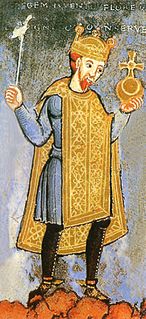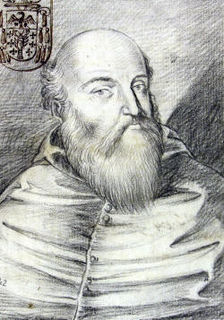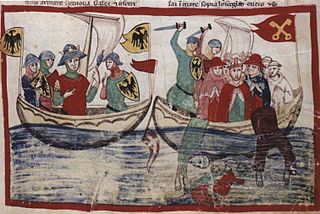
Pope Gregory XI was head of the Catholic Church from 30 December 1370 to his death in 1378. He was the seventh and last Avignon pope and the most recent French pope recognized by the modern Catholic Church. In 1377, Gregory XI returned the Papal court to Rome, ending nearly 70 years of papal residency in Avignon, France. His death shortly after was followed by the Western Schism involving two Avignon-based antipopes.

Pope Gregory XIII, born Ugo Boncompagni, was head of the Catholic Church and ruler of the Papal States from 13 May 1572 to his death in 1585. He is best known for commissioning and being the namesake for the Gregorian calendar, which remains the internationally accepted civil calendar to this day.

Pope Gregory VII, born Hildebrand of Sovana, was head of the Catholic Church and ruler of the Papal States from 22 April 1073 to his death in 1085. He is venerated as a saint in the Catholic Church.

Jean de Murat du Cros was a French cardinal of the Catholic Church. He became the Bishop of Limoges (1347–1371). He was a leader in what became the Great Schism within Western Christianity.

The bishop of Ostia is the head of the suburbicarian diocese of Ostia, one of the seven suburbicarian sees of Rome. Since 1150, the bishop has been the dean of the College of Cardinals, with the actual governance of the diocese entrusted to the vicar general of Rome.
Uberto Lanfranchi was the Cardinal-deacon of Santa Maria in Via Lata, then the Cardinal-priest of San Clemente, and finally the Archbishop of Pisa.

The Roman Catholic Suburbicarian Diocese of Palestrina is a Roman Catholic suburbicarian diocese centered on the comune of Palestrina in Italy.
Hugh of Remiremont, called Candidus or Blancus, was a medieval cardinal.
Cuno of Praeneste was a German Cardinal and papal legate, an influential diplomatic figure of the early 12th century, active in France and Germany. He held numerous synods throughout Europe, and excommunicated the Emperor Henry V numerous times, in the struggle over the issue of lay investiture of ecclesiastical offices. He spent six years promoting the acceptance of Thurstan of York as archbishop by King Henry I of England, without making York subject to Canterbury. He was seriously considered for election to the papacy in 1119, which he refused.
Liemar was archbishop of Hamburg-Bremen from 1072 to 1101, and an important figure of the early Investiture Contest.

The history of the papacy from 1046 to 1216 was marked by conflict between popes and the Holy Roman Emperor, most prominently the Investiture Controversy, a dispute over who— pope or emperor— could appoint bishops within the Empire. Henry IV's Walk to Canossa in 1077 to meet Pope Gregory VII (1073–85), although not dispositive within the context of the larger dispute, has become legendary. Although the emperor renounced any right to lay investiture in the Concordat of Worms (1122), the issue would flare up again.

The 1073 papal election saw the election of Hildebrand of Sovana as successor to Pope Alexander II.

Marco Cornaro was an Italian Roman Catholic cardinal and bishop.

Uberto Gambara (1489–1549) was an Italian Roman Catholic bishop and cardinal.

Gianfrancesco Gambara (1533–1587) was an Italian Roman Catholic cardinal and bishop.

Marco Antonio Colonna (1523–1597) was an Italian Roman Catholic bishop and cardinal.
Atto was a Cardinal of the Catholic Church who lived in the 11th century.

Amatus was an eleventh-century French prelate, Catholic Bishop and Papal Legate.
Uberto Coconati, a Roman Catholic Cardinal, was born at Asti in the Piedmont region of Italy, a member of the family of the Counts of Cocconato, who were vassals of the Marchese di Monferrato. Thierry de Vaucouleurs, the author of the Johanneslegende, Uberto was "Lombardus nomine, stirpe potens".

James of Pecorara or Giacomo da Pecorara was an Italian monk, cardinal and diplomat.